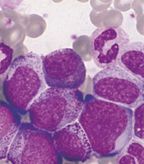Intermittent Imatinib for Elderly CML Patients Shows Promise
A phase II study found that an alternative imatinib treatment schedule for elderly patients with chronic myeloid leukemia (CML) could be an effective way to reduce dosing requirements of the drug.
A phase II study found that an alternative imatinib treatment schedule for elderly patients with chronic myeloid leukemia (CML) could be an effective way to reduce dosing requirements of the drug. The schedule of treatment involved 1 month on, 1 month off, and appeared to affect markers of residual disease but not overall and progression-free survival.

Photomicrograph of chronic myeloid leukemia; © Prof. Jean Bonhomme
“With imatinib at the standard dose of 400 mg daily, 80% to 90% of patients are alive at 8 years, but only a small proportion of patients (about 5%) can discontinue the treatment without suffering a molecular recurrence,” wrote investigators led by Domenico Russo, MD, of the University of Brescia in Italy, online ahead of print on May 15 in the journal Blood. “Thus, the great majority of responsive patients would be destined to continue the treatment indefinitely, at the same standard dose.” To address attendant problems of treatment compliance and toxicity, Dr. Russo and colleagues conducted the single-arm phase II INTERIM study to investigate a 1-month-on, 1-month-off (following a 1-week, and then 2-week alternation schedule to ease into the new schedule) treatment schedule for imatinib in patients over the age of 65.
All patients in the study had been on imatinib for at least 2 years and were in stable complete cytogenetic response; a total of 76 patients were included in the study. The median duration of treatment at study entrance was 60 months, and 81% were on the 400-mg dose “in spite of the age and the long treatment duration,” the authors wrote.
Thirteen patients (76%) lost cytogenetic response and molecular response, and all except one who was lost to follow-up regained both after resuming standard, continuous imatinib treatment. Six of those patients lost the response during the first 12 months, and the other seven lost it between the 13th and 27th month. Fourteen other patients lost major molecular response only, nine of whom resumed continuous imatinib therapy and regained major molecular response.
No patients in the study progressed to accelerated or blast phases of CML, though two patients died during the study, because of acute myocardial infarction in one and intracranial hemorrhage in the other. The estimated progression-free survival at 12 months was 100%, and 96% at 48 months. The toxicities reported all existed when patients enrolled in the study, and no patients reported new or more severe adverse events during the “on” months of treatment.
“The results of this study do not allow us definitively to conclude that intermittent treatment can be offered to optimal and stable responders, but opens a window to alternative treatment policies, even in the patients for whom a very deep molecular response cannot be achieved,” the authors concluded.
Highlighting Insights From the Marginal Zone Lymphoma Workshop
Clinicians outline the significance of the MZL Workshop, where a gathering of international experts in the field discussed updates in the disease state.